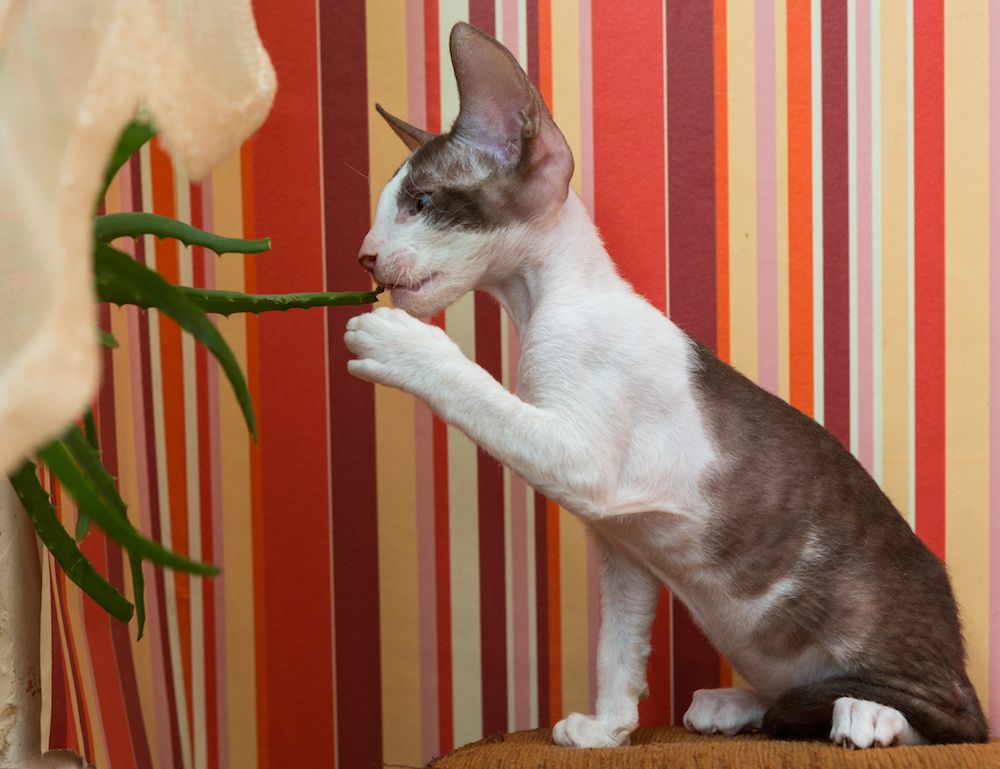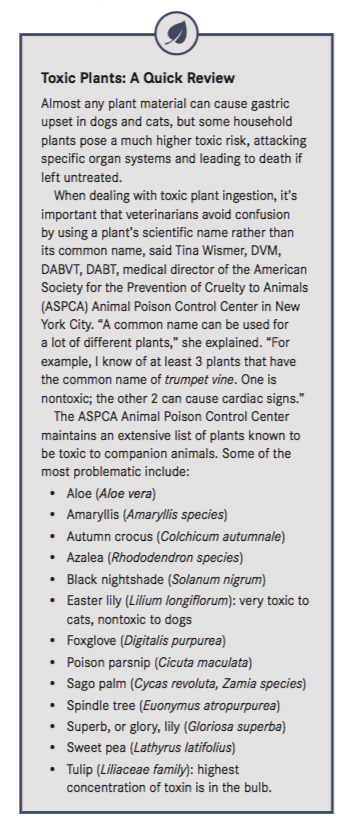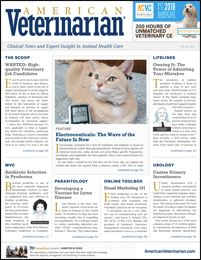Code Green: The Risk From Toxic Household Plants
Ingesting certain plants can be deadly for dogs and cats. Here’s what you need to know to educate your clients and keep your patients safe.

Many common household plants, such as aloe, can be toxic to pets.
When 20-month-old Jessie started vomiting, her owners, Catherine and Bruce Campbell of Wilmington, North Carolina, were puzzled. The rambunctious golden retriever hadn’t gotten into dinner scraps, and nothing seemed out of place. The Campbells went to bed assuming Jessie would be better in the morning.
But Jessie wasn’t better. In fact, she had become so lethargic that the Campbells rushed her to Hanover Regional Animal Hospital, where John Manolukas, DVM, PhD, referred them to a specialty hospital in Cary, 2 hours away. The doctors there started treating Jessie for shock and questioned whether she had gotten into an ant nest or a bee hive or had eaten candy containing xylitol. Finally, the veterinarian asked whether the Campbells had sago palms in their yard. They did, several of them. Bruce went out to check and found that Jessie had chewed up numerous budding fronds.
RELATED:
- The Poison Potential of Succulents
- IVECCS 2017: Advances in Companion Animal Toxicology
Jessie was given plasma transfusions because she had started bleeding out of her anus. Once she was stable, the Campbells returned with her to Wilmington, where Dr. Manolukas continued treatment. But nothing worked. “We saw Jessie on Saturday, and I could see that she had turned yellow from jaundice,” Catherine said. “My husband had left the room, and Jessie let out a huge puddle of blood. It was very disturbing. I had worked as an administrator at a veterinary hospital, so I knew what was happening. I was hoping they could save her, but the sago palm destroyed her insides. She died the following Monday.”
Although he has been a professional landscaper for more than 20 years, Bruce Campbell, like most pet owners, had no idea that sago palms are extremely toxic to dogs. As a result of their experience with Jessie, the Campbells immediately had every sago palm removed from their property. In an effort to educate others, Catherine created a brochure about the risk, which she hands out to the pet owners she meets while walking. “I just want people to be aware so they don’t go through the same thing we did,” she said.
The sago palm is just 1 example of the many popular plants that can be toxic to pets if ingested. According to Tina Wismer, DVM, DABVT, DABT, medical director of the American Society for the Prevention of Cruelty to Animals (ASPCA) Animal Poison Control Center in New York City and master gardener, this plant was once found only in warm regions of the United States, but miniature sago palms are now sold at many nurseries and home supply stores, giving pets even greater access to a deadly plant. “Sago palms usually are not labeled in stores, so people will buy them not knowing how toxic they can be,” she said. “It’s important that pet owners do some research before bringing a plant into their home or new plants to be used for landscaping.”
Increasing the risk for family pets is the common misconception that dogs and cats intuitively know which plants are OK to chew on and which are not. Such is not the case, said David Dorman, DVM, PhD, DABVT, DABT, professor of toxicology at North Carolina State University College of Veterinary Medicine in Raleigh. “Owners don’t quite appreciate that animals are just like us—they don’t know what’s good for them; they don’t know which plants are toxic,” Dr. Dorman explained. “Pets are just as ignorant as we are.”
Plant Poisoning Statistics
Just how common are cases of toxic plant ingestion? According to Dr. Wismer, plant ingestion comprised 5.4% of the more than 199,000 calls received by the ASPCA Animal Poison Control Center in 2017. “That’s more than 10,700 calls for the year, or around 29 calls a day,” Dr. Wismer reported.
Dogs and cats, because they commonly explore their environment by chewing or licking, are the largest patient cohorts in terms of plant ingestion calls, Dr. Wismer added. “They make up probably 96% of our cases. The next largest group is rabbits, followed by birds, which get into houseplants if allowed to fly inside the home.”
Common Toxic Household Plants
Toxic plants come in all types and affect the body in different ways, noted Bruce Kornreich, DVM, PhD, DACVIM, associate director of education and outreach at the Cornell Feline Health Center and clinical cardiologist in the Department of Clinical Sciences at Cornell University College of Veterinary Medicine in Ithaca, New York. Lilies, for example, are extremely toxic to cats and can result in renal failure and death, while plants such as foxglove—from which the heart medication digoxin is derived—can result in an abnormal cardiac rhythm, low blood pressure, and other potentially life-threatening effects. And the sago palm can result in liver failure, among other conditions.
“Some common houseplants, such as dieffenbachia and philodendron, contain insoluble oxalate crystals, which look like little needles,” Dr. Wismer added. “When an animal eats these plants, the crystals shoot into their tongue and gums, resulting in drooling as well as vomiting and gagging. It’s not life-threatening in most cases, but it can be extremely painful.”
Wild mushrooms, while not plants, are another area of concern. Identification is vital, Dr. Wismer noted, because the effects of wild mushrooms can range from mild gastrointestinal (GI) upset to liver failure and death. Unfortunately, owners may have no idea what their pets got into, and early symptoms may mimic those of other disorders. The treatment for mushroom toxicity is similar to that for toxic plant ingestion.

Pet owners should also be cautious about the use of herbs around their pets. Most herbs commonly used in cooking are relatively harmless, perhaps resulting in mild stomach upset, but concentrated herbs may cause more serious problems. Dr. Wismer recalled a cat that had licked some concentrated oregano oil and experienced burns in its mouth. “If it had just eaten the plant, we would expect stomach upset,” she said. “But the oil was a whole magnitude greater in concentration.”
Treatment
Treatment for toxic plant ingestion is dependent on a variety of factors, including the type of plant, the amount ingested, and the plant’s effects on specific organ systems. Treatment typically begins by identifying the plant, if possible, and then performing blood tests to determine which organ systems might be damaged. “In the case of liver damage, you might find elevated enzymes,” Dr. Kornreich noted. “In the case of kidney damage, you might find elevations in the by-products that are normally removed from the bloodstream by the kidneys.”
In some cases, induced vomiting might be warranted to remove the plant material from the stomach. If that is not an option, activated charcoal may be used to absorb toxic substances in the GI tract. From there, gastric protectants such as sucralfate may be used to protect areas of the stomach damaged by local irritation or chemical principles within the plant, Dr. Kornreich explained.
The final stage of treatment is addressing the effects of the plant on specific organ systems, such as the heart, liver, kidneys, and GI system. “In dealing with the acute effects on organ systems, there may be chronic effects,” Dr. Kornreich warned. “If a cat ingests lilies and survives, it may be that the cat will experience kidney problems for the rest of its life and may benefit from dietary modification and other approaches to treat that specific organ.”
Communicating the Dangers to Clients
Toxic plant ingestion is an issue that veterinarians see often, and it falls on practitioners to remind clients regularly of the potential risk through email blasts, practice newsletters, and handouts featuring specific resources. Foremost is the ASPCA Animal Poison Control Center website. In addition to providing treatment information to veterinarians and pet owners, the site features an extensive list of plants and their potential for toxicity.
“The most critical thing is prevention,” Dr. Dorman concluded. “In a lot of ways, I believe we in the veterinary tend not to be as proactive as we should be about informing pet owners, especially new owners of companion animals, about potential hazards they might encounter. Directing clients to resources such as the ASPCA website and other poison control websites is a good way to educate them about which plants to avoid. Prevention should always be our main goal.”
Don Vaughan is a freelance writer based in Raleigh, North Carolina. His work has appeared in Military Officer, Boys’ Life, Writer’s Digest, MAD, and other publications.
